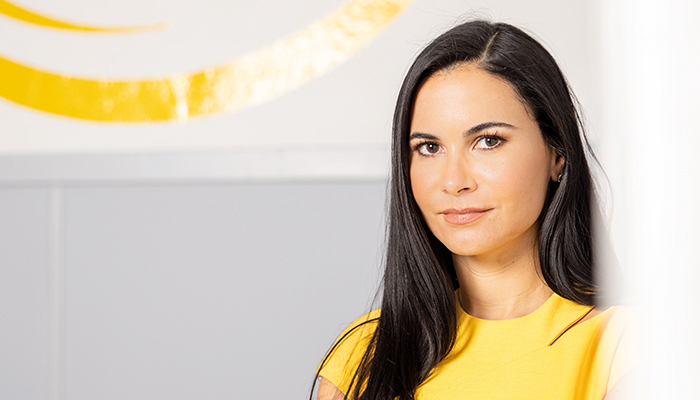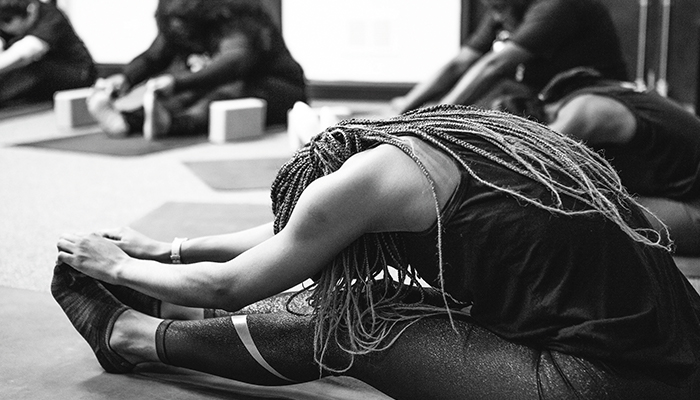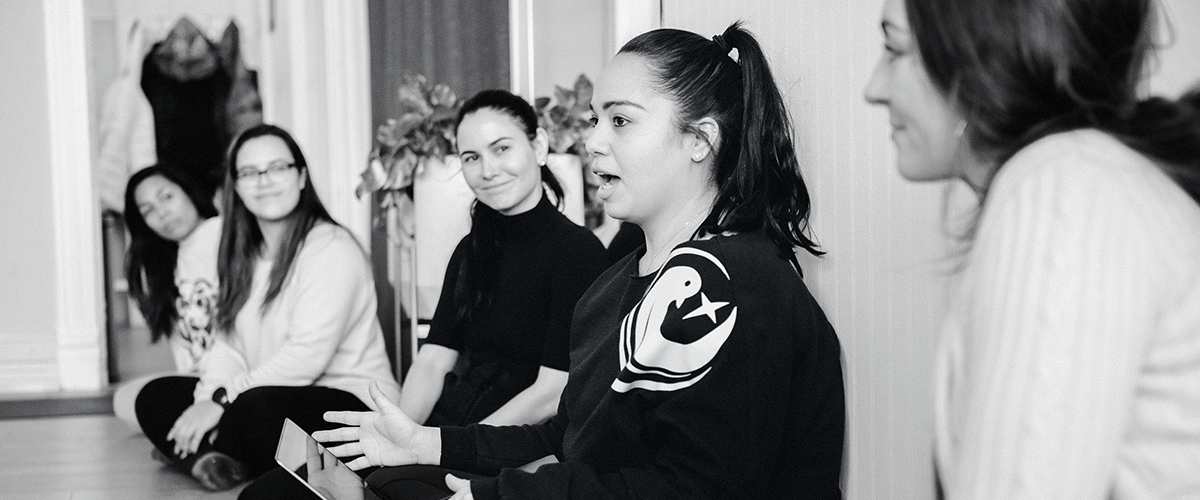Salt & Light: A Healing Coalition
Izabel Olson (PhD14) was teaching a women’s yoga class at Chicago’s Cook County Jail when she learned that many of her students were survivors of sex trafficking.
How was it, she wondered, that she hadn’t gone down the same path, given that her own early life paralleled those of some of the incarcerated women?
That question became the catalyst for the nonprofit Salt & Light Coalition, a program Olson founded to “heal, educate, and empower” survivors of human trafficking. Drawing on both her personal experience and the learning sciences doctorate she earned at SESP, Olson designed a holistic yearlong curriculum around health and wellness, spirituality, job training, and entrepreneurship.
“My own early life was a struggle: I experienced homelessness. My father was in jail. I was a single mom by 18,” Olson says. “I realized why I had not been trafficked: education, community, yoga, and faith. I recognized that if Salt & Light could bring those protective factors to women, we could help them heal.”

Addressing trauma and vulnerability
Although the underground nature of trafficking makes exact figures hard to obtain, evidence suggests that at least 16,000 women and girls in Chicago are involved in the commercial sex trade each year, according to the Illinois Department of Human Services.
Olson’s all-volunteer Salt & Light Coalition, which takes its name from a Bible verse, began in 2017 in Chicago with a cohort of five women. Prior to the COVID- 19 pandemic, the program was accepting 40 women a year and preparing them for careers in the wellness sector. Participants received a Chicago transit card and a stipend to help them avoid the leading causes of recidivism: financial pressures and lack of job training.
“Poverty, immigration status, and previous abuse or assault are key risk factors,” says SESP assistant professor of human development and social policy Tabitha Bonilla, who studies public understanding of human trafficking and what efforts to fight trafficking look like in communities. “By addressing trauma and basic life needs, Olson is chipping away at what made these women susceptible in the first place.”
Under nonpandemic circumstances, the women of Salt & Light gather twice a week in a cozy two-room space in Chicago that formerly housed a yoga studio. The program’s first six months include trauma-sensitive yoga, reflection, and meditation to help the women reconnect with their bodies and reduce anxiety and stress. They also learn about the crucial roles of nutrition and exercise in both physical and mental health.
Yoga changed how Taylor Holm viewed her body. “I didn’t see it as a temple, or anything important,” says Holm, 23, who completed the program in 2018 and now teaches yoga. “My body was something to be used, a tool to get something I wanted. Through yoga, I started becoming aware of how every part of my body felt. Certain positions brought up emotions and trauma, but this helped me start to heal.”
The program’s second six-month phase emphasizes education and job training. Women work with mentors and start yoga teacher training—not necessarily to prepare them to teach yoga but to rebuild their ability to communicate. About 20 percent of the women do go on to teach yoga, Olson says.
“Women who are trafficked are often told not to speak,” Olson says. “When they come into the program, they learn to be communicative through yoga.”
The women also practice key workplace skills like communication, leadership, and empathy and start thinking about longer-term goals such as getting a degree or starting a business. Personal stylists and life coaches help them gain confidence to reenter the work force. In a role-playing exercise, volunteers act like employers and listen to mock elevator speeches.
During the program’s final month, women entrepreneurs give presentations on how to create a business, and the women in the program compete in a Shark Tank–like competition. “The goal isn’t to launch a company or get an MBA,” Olson says. “Rather, it’s to stress the point that something is possible if they dream.”

A nimble transition
Olson’s response to the COVID-19 pandemic and the statewide shelter-in-place orders was swift, multilayered, and a testament to the strength of her partnerships and her stable of volunteers.
To maintain community and stability, she transitioned Salt & Light’s programs to all-virtual or hybrid formats; a church partner donated tablets to help ensure that participants could have online access.
Each woman attended a weekly teletherapy session and received frequent check-in phone calls from Salt & Light staffers. Olson’s partners, including a restaurant and another church community, both based in Chicago, helped deliver groceries and restaurant-quality meals twice a week—along with flower arrangements on Mother’s Day.
In the spring Olson developed Pass the Salt, a series of webinars in the form of dinner conversations on various facets of the human-trafficking problem. The series, which included powerful personal testimonies from women in the program, also helped families learn how to recognize signs of trauma and discussed the role of faith in moving forward.
It’s a fact:
Sex or sex and labor trafficking accounted for nearly 80 percent of the Illinois trafficking cases reported to the National Human Trafficking Hotline in 2019.
There were, of course, serious challenges to transitioning the program to a hybrid model, where half of the participants are on site with masks and the other half take part via Zoom. “We’ve had issues with the offline-versus-online dynamic, but we’re trying different equipment to see if we can find the right balance,” Olson says.
Overall, the online component has worked better than she expected. “The phone check-ins may have made the difference,” she says. “The structure helped the women get through the quarantine.”
The switch to online delivery was also a “great opportunity to understand the impact of a different medium on our outcomes and attrition rates.” Olson says. An online module that could expand her healing model to reach women across the country is in the works.
From Rio to Evanston
As a teenager in Brazil, where most of her extended family still lives, Olson found herself in an abusive relationship. By 18, she was alone and pregnant with her son, Gabriel. It was a hard road, she says, but one that prepared her for what she is doing now.
She credits her mother’s unflagging belief in education—and a strong conviction that her daughter could accomplish whatever she set her mind to—with helping turn her life around. “I had no choice but to believe I could succeed, because she was so passionate in believing I could do anything,” Olson says. “Because of her, fear was never part of my psychology.”
Before starting her SESP doctoral program in 2009, Olson earned bachelor’s and master’s degrees in linguistics and teaching by attending night school in Rio de Janeiro. She spent her days working as a teacher in wealthier parts of the city and volunteered after work in the favelas, the poorer areas on the outskirts of town.
It’s a fact:
94 percent of Salt & Light’s women have histories of substance abuse, and 77 percent have had mental health issues.
Her learning sciences dissertation, which won an American Education Research Association award for best student paper in 2013, examined the relationship between cognition and culture and looked at how favela dwellers’ social experiences affect their thinking about complex situations.
Although Olson loved her graduate work, she wasn’t feeling a natural flow to her life. “There’s a sweet spot between working hard and finding the path of least resistance,” she said in a Q&A on the website Seriously Badass Women. “I call that my rhythm of grace. If that energy is not there in my work, I stop and reassess.”
Olson hit her stride once she began talking about launching a nonprofit. She had no experience, but “it was like I spoke it into being,” she says. When she met Rosemary Grant Higgins, a retired Chicago criminal courts judge who had presided over commercial sexual exploitation cases for two decades, things began falling into place.
Higgins helped her set up partnerships and meet key people. Olson sat down and wrote the curriculum, drawing on her doctoral training and her experiences in the antitrafficking community. “I noticed gaps that needed to be filled if the cycle of trafficking was to be broken,” she says.
The curriculum includes a research component, which Olson calls the program’s backbone. The women complete surveys both when they arrive and when they leave. The exit interview allows the women to give feedback, enabling the program to better serve the next cohort.
Still, about half of the women drop out before finishing, Olson says. “Many of the women have experienced a level of brokenness that doesn’t allow them to believe we are here to support them,” she says. “Others have issues beyond our control: housing, childcare, several deaths in the family—you name it.”
It’s a fact:
88 percent of Salt & Light graduates secure a job at the end of the program.
Moving toward the light
Even though she already has her PhD in learning sciences, Olson has returned to school to pursue a master’s in counseling through Northwestern’s Center for Applied Psychological and Family Studies.
Meanwhile, she wants Salt & Light’s future direction to be set by the coalition’s community. Two graduates, Holm and Patience Roberts, have worked as peer support specialists. Graduates also sit on the advisory board, and their input has helped shape the job-training curriculum.
“I’m more than just a support system. I hold them accountable,” says Holm, who meets regularly with the women. “They see me a little bit different because I’ve been through what they’ve been through. I call and say, ‘Did you get your driver’s license yet?’ If not, I’ll pick them up or meet them. I’m there to help them start doing things.”
Olson’s data also suggest that the program is working, at least initially. In a recent poll of those who had graduated at least a year earlier, 80 percent were still part of the workforce a year following graduation.
“I work three or four jobs, but it feels so much better working hard for my money than doing something that’s destroying me on the inside,” says Holm, who wants to become a certified alcohol and drug counselor or a life coach. “I’m so grateful for my life now.”
COALITION VOLUNTEER NATASHA VASAN
SESP undergraduate Natasha Vasan wrote Salt & Light’s first successful grant application during her summer practicum, an experience that changed her life. She now hopes to study law “to fight for those whose voices are taken from them, who are born without a voice, or whose voices are inherently quieter or less likely to be heard,” she says.
The women of Salt & Light taught Vasan that “the inescapable victimhood, mental and physical abuse, and subjectification of being trafficked not only made speaking up impossible, it caused them to believe that no one would listen,” Vasan wrote in her application to law school. “I saw firsthand how oppression and subjectivity are agents that mute. It is not fair—or acceptable.”
Although her practicum has ended, Vasan is still volunteering as a grant writer for Salt & Light. “It was a really good feeling to do something outside of school that made an impact,” she says.

